Belarusian Gothic
Belarusian Gothic (Belarusian: беларуская готыка, romanized: bełaruskaja hotyka) is the architectural style of ecclesiastical buildings and fortified structures of the 15th and 16th centuries in modern Belarus, Lithuania, eastern Poland and western Ukraine.[1]
Although these buildings have features typical of Gothic architecture such as lofty towers, flying buttresses, pointed arches and vaulted ceilings, they also contain elements not typically considered Gothic by Central and Western European standards.
Terminology
The term was introduced by Belorussian historian Mikoła Ščakacichin in his work "Essays from the history of Belarusian art"[2] in 1920s. Initially supported by Belorussian historians,[3] in 1960s-80s it gained recognition amongst some of the Russian[4] and Lithuanian historians.[5]
Depending on the area it can also be referred to as Ukrainian[1] and Lithuanian.[6]
History
With the baptism of the Grand Prince Vladimir the Great and the Christianization of the Kievan Rus', the region's architecture became heavily influenced by Byzantine architecture.
During the 13th century and start of 14th century, the Slavic principalities are eventually subjugated by the Grand Duchy of Lithuania, a pagan state which was fighting against the Teutonic Order's expansion. The Grand Duchy became a dominant power in the 14th century, featuring a developed Lithuanian nobility. Lithuanian rulers started building Brick Gothic castles and establishing Catholic churches, which were also constructed in Brick Gothic. Contacts with the Teutonic order and Europe allowed to hire experienced architects.
The Act of Krėva in 1386 caused the Christianization of Lithuania and increased communication in western and southern Europe. Christianization of Lithuania led to more intensive expansion of Western culture and namely, Gothic style into Orthodox lands.
During this period, the Gothic style came to the Slavic regions. In central and southern Europe however, it was already being displaced by Renaissance architecture.
In 1346 the Orthodox Cathedral of the Theotokos, Vilnius[7] in Vilnius, was constructed, before the Lithuanian state had become Catholic. (see history of Roman Catholic Lithuania).
- Examples
Cathedral of Ss. Boris and Gleb,[8] Navahrudak (1519–1630), southern façade
The 16th-century Mir Castle
Church of Supraśl Orthodox Monastery, Poland
Church in Muravanka
Architecture
Belarusian Gothic combines Byzantine, Gothic, and Renaissance architecture. Although some buildings have a north-German Brick Gothic design, others are plastered. Window arches are primarily pointed, but blind arcades and Lombard bands have round arches. Most churches have rib vaults, but there are also simple massive trunks such as those in Romanesque and Byzantine architecture. Most were fortified, with a short nave and a small tower at each corner; others have an ordinary, high, Western bell tower.[11]
References
Sources
- Nigel Roberts, Belarus, p. 185 (google books)
- Rainer Lindner, Historiker und Herrschaft: Nationsbildung und Geschichtspolitik in Weißrußland im 19. Und 20. Jahrhundert, Verlag Oldenbourg 1999, ISBN 3-486-56455-2, S. 256, II. Nation und Geschichte im Stalinismus → 3. Rivalität der Mythen (Nation-building and policy of history in Belarus in the 19th & 20th centuries) – in German
- Archives of Belarus, Church Architecture
- Беларуская готыка ў пабудове культавых будынкаў XV-XVI стст. – Belarusian Gothic in religious buildings of the 15th and 16th centuries (in Belarusian, very much illustrated)
https://en.wikipedia.org/wiki/Belarusian_Gothic
Venetian Gothic architecture
Venetian Gothic is the particular form of Italian Gothic architecture typical of Venice, originating in local building requirements, with some influence from Byzantine architecture, and some from Islamic architecture, reflecting Venice's trading network. Very unusually for medieval architecture, the style is both at its most characteristic in secular buildings, and the great majority of survivals are secular.
The best-known examples are the Doge's Palace and the Ca' d'Oro. Both feature loggias of closely spaced small columns, with heavy tracery with quatrefoil openings above, decoration along the roofline, and some coloured patterning to plain wall surfaces. Together with the ogee arch, capped with a relief ornament, and ropework reliefs, these are the most iconic characteristics of the style. Ecclesiastical Gothic architecture tended to be less distinctively Venetian, and closer to that in the rest of Italy.
The beginning of the style probably goes back no further than the 13th century, although the dates of early Gothic palaces, and especially features such as windows in them, are largely uncertain. It dominated the 14th century and because of the city's conservatism Venetian Gothic buildings, especially smaller palaces, continued to be built well into the second half of the 15th century,[1] and Venetian Renaissance architecture very often retained reminiscences of its Gothic predecessor.
In the 19th century, inspired in particular by the writings of John Ruskin,[2] there was a revival of the style, part of the broader Gothic Revival movement in Victorian architecture. Even in the Middle Ages, Venetian palaces were built on very constricted sites, and were tall rectangular boxes with decoration concentrated on the front facade. The style was therefore developed for a similar architectural context to that found in late 19th-century city centre streets.
Context
Venice is built on alluvial mud, and all buildings in the city were (and mostly still are) supported by large numbers of timber piles driven into the mud. Above that the normal building material is brick, although the grander facades were usually faced with Istrian stone, a fine limestone that is not strictly a marble, although it is often so called. This came by sea from quarries in Istria in the Terraferma, now in Croatia. Other stones with different colours were often used for contrast, especially a red stone from Verona. Marmorino stucco, made from grinding limestone, brick and terracotta fragments, was the typical finish for interior walls, and sometimes exteriors.[3] Flat ceilings supported with timber beams were preferred to vaults, which might crack as the building settled on the pile foundations.[4]
The main city was already very largely built up, with buildings tightly packed in the centre; this is shown clearly by Jacopo de' Barbari's huge woodcut View of Venice with an elevated view of the city in 1500. Because buildings were tightly packed, Venice was even more prone than other Italian city centres to fires, creating the need for many of the new buildings.
Palaces
Unlike the palaces or houses of wealthy families in other Italian cities, defence was not a major concern for Venetian palaces, which in any cases often had "moats" on some sides. The crowded city centre encouraged building high by the standards of the period, and the main access for light was often from the front facade, which therefore typically has more and larger windows than palaces elsewhere.[5]
Most palaces doubled as places of business, on the ground floor, and homes above. The ground floors, which even when built were probably rather prone to periodic flooding, have relatively few rooms, and a rather grand stairway leading to the residential upper floors, where ceilings are rather low by the standards of palaces. The portico on a canal allowed goods to be loaded and unloaded, and led to a large space called the androne, where they were stored and business transacted. Upstairs, the portego or salone was another large room, centrally placed and usually "T"-shaped, received light from the windows and was the main space for dining and entertaining. To the rear an open staircase led to a small courtyard with a well-head and often a rear door to the street.[6] In fact there are no true wells in Venice, and the well-head led down to a cistern sealed from the salty groundwater, which collected rainwater from the roof and courtyard through stone gutters leading to a sand filter system and the cistern.[7]
By the 13th century porticos at the front were often abandoned, and replaced by one or more large doorways leading to the androne.[8]
History
The Gothic Period arrived in Venice during a time of great affluence, when the upper class was funding the building of new churches as well as new, opulent homes for themselves. At the same time, the religious orders were beginning to bring the Gothic style to Venice's churches from mainland Italy. The most striking examples of this new architectural fashion can be seen in Santi Giovanni e Paolo and the Frari. However, these churches were still very similar to those found in the rest of Italy, the main difference being the building materials. It was not until the increase in palace construction, that Venetian Gothic became a distinct style in itself. Influenced by the Doge's Palace, the creators of this new style meshed Gothic, Byzantine, and Oriental themes to produce a totally unique approach to architecture.
Characteristics and examples
As described by Ruskin, the ogee arch was at the start of the stylistic development of the Venetian Gothic arch, rather than in the middle or at the end, as elsewhere. Round arches began to sprout points on their outer rim, while initially remaining circular on the inside.[9] But neat progressions of style are not always reflected in actual buildings, and a variety of styles can sometimes be seen in a particular period, and in the same building.[10]
The ogee arch is "relatively uncommon in ecclesiastical buildings", where a more conventional Italian Gothic was adopted (and there are fewer survivals). Conversely, conventional Gothic arches are seen in palaces "only in the most solid elements". Because the unstable ground discouraged vaulting, the "structural raison d'etre of Gothic architecture – to allow the erection of higher and higher vaults, with more flexibility in ground-plan – was completely irrelevant in Venice".[11]
In Northern Europe, traceries only supported stained glass. In contrast, traceries in Venetian Gothic supported the weight of the entire building. Therefore, the relative weight sustained by the traceries alludes to the relative weightlessness of the buildings as a whole.[12] This (and the associated reduced use of weight-bearing walls) gives the Venetian Gothic architectural style lightness and grace in structure.
The Venetian Gothic, while far more intricate in style and design than previous construction types in Venice, never allowed more weight or size than necessary to support the building. Venice had always held the concern that every inch of land is valuable, because of the canals running through the city.
One major aspect of the Venetian Gothic style change that came about during the 14th and 15th centuries was the proportion of the central hall in secular buildings. This hall, known as the portego, evolved into a long passageway that was often opened by a loggia with Gothic arches. Architects favored using intricate traceries, similar to those found on the Doge's Palace.[13] The most iconic Venetian Gothic structure, the Doge's Palace, is a luxuriously decorated building that includes traits of Gothic, Moorish, and Renaissance architectural styles. In the 14th century, following two fires that destroyed the previous structure, the palace was rebuilt in its present, recognizably Gothic form.[14]
Churches
The two largest Gothic churches to remain largely unaltered are those of the main mendicant orders; both are designed to provide large open spaces for star preachers to reach big congregations. These orders were controlled from the Italian mainland, and their original architecture mostly reflected broader Italian styles developed by each order elsewhere, and so represented a novelty in Venice. Both became home to numerous important wall tombs inside,[15] which has probably prevented the interiors from having Baroque makeovers, as has happened elsewhere.
The Frari is the Franciscan church. Like most medieval Franciscan churches, this is a large plain building, built economically to hold large crowds to hear star preachers. First constructed in the 13th century, it was rebuilt in its current Gothic style over a long period in the 14th and 15th centuries.[16]
The rival Dominican church of Santi Giovanni e Paolo is the other large Gothic church in the city that retains its original character. This was first begun in the 1240s, but that church was too small, and the current building was probably begun in 1333, although not consecrated until 1430.[17] Many other churches retain significant Gothic work, especially Santo Stefano, a large parish church with a "ship's keel" wooden roof.[18] The Madonna dell'Orto, built by the Humiliati order, is mostly 14th-century, but the facade, still Gothic, dates to the 1460s. Other Gothic churches have been given makeovers in Renaissance or Baroque styles. In San Marco, the main church of the republic, there is much Gothic sculpture on the facade, and other details, but the main elements of the structure remain Italo-Byzantine Romanesque.
Islamic and Byzantine influence
The influence of Islamic architecture is reflected in some features of the Venetian style, in particular the use of colour and pattern on outside walls, and sometimes stone grills on windows, and perhaps purely decorative crenellations on rooflines. During the period the Venetian economy was heavily bound up with trade with both the Islamic world and the Byzantine Empire, and the architectural styles of these two are somewhat entangled, especially in the early Islamic period.[19]
As an example, decorating walls with large veneers of fancy coloured marble or other stones, which was certainly a Venetian taste, was also found in Byzantine and Islamic architecture, but both had derived it from imperial Roman architecture. There are still examples in Ravenna (ruled by Venice from 1440 to 1509), Milan as well as Rome, and very likely much of the stripping of these from other surviving Roman buildings had not yet taken place.
Venetians may also have regarded some aspects of Byzantine and Islamic architecture as reflecting the world of Early Christianity – all over Italy "eastern" costume very often served for biblical figures in art, and the paintings of some Venetians, for example St Mark Preaching at Alexandria by Gentile Bellini (c. 1505) also use clearly Islamic architecture (including stone grills), although also reflecting the Byzantine styles of Constantinople, which Bellini visited in 1479, only some twenty-five years after it became the Ottoman capital. There were also Venetian connections with Islamic styles though Sicily and southern Italy, and possibly al-Andalus (Islamic Spain). Venetians probably saw the eastern elements in their architecture in a complex way, reflecting and celebrating both their history and the cause of their trade-derived wealth.[20]
Venetian traders, and those of rival cities, reached into Persia and Central Asia in the Pax Mongolica after the Mongol conquests, from roughly 1240 to 1360.[21] There were small Venetian colonies of merchants in Alexandria, as well as Constantinople. Venice's relations with the Byzantine Empire were still more intimate and complicated, involving many wars, treaties, and massacres.
Ca' Foscari, built in late Venetian Gothic style.
Ca' Barbaro on the Grand Canal.
Palazzo Dario was later renovated with Renaissance features. On the left, Palazzo Barbaro Wolkoff.
Palazzo Bembo on the Grand Canal, close to the Rialto Bridge.
Santi Giovanni e Paolo, 1340s
Palazzo Foscari on the island of Giudecca.
Palazzo Dandolo, somewhat "restored" and elaborated in the 19th century.
Palazzo Loredan dell'Ambasciatore. The rectangular windows of the mezzanine show this is fact a late 15th-century building, retaining a Gothic style into the Renaissance.
Palazzo Pisani Moretta in the sestiere of San Polo.
Revival
The style was revived in the 19th century, largely through the influence of British architectural critic John Ruskin and his treatise The Stones of Venice. Because of the shortage of space in Venice, most palazzi were high (by medieval standards) rectangular boxes, with an ornamented facade, but very often plain on the other external elevations. Nor did they have space-wasting courtyards. Hence the basic shape suited 19th-century requirements very well, and the Venetian-ness of the style appeared mainly in the elaborate windows, cornice and other decoration to the facade.
In North America the style was popularized by architects Charles Amos Cummings, Frank Furness, Norman Shaw, William Robert Ware, Willard T. Sears, and Frederick William Stevens. In Australia, the architect William Pitt was an exponent of the style and Joseph Reed was known to experiment in it also.
The Montauk Club is an example of this style located outside of Venice in Park Slope, New York City, (1878)
The former stock exchange on Collins Street, Melbourne was designed in the Venetian Gothic style by architect William Pitt.
The western façade of a former carpet factory in Glasgow.
National Academy of Design in New York, (1863–65).
Memorial Hall in Manchester, England (1866).
Church of St. Anthony of Padua (1912) in Istanbul
Elephant Tea Rooms, Sunderland, England (1872-77).
Our Boys Institute, Adelaide, Australia (1896).
Vergara Palace, Viña del Mar, Chile (1910).
Ismailiyya Palace in Baku, Azerbaijan (1908–13).
Palazzo Cavalli-Franchetti, Venice, (1878).
Caffè Pedrocchi in Padova, (1839).
Isola del Garda, Brescia, (1903).
Hallwyl Museum, Stockholm, (1898).
See also
Notes
- Mack, 15-21
References
- Burns, Howard, "Architecture", in Jane Martineau (ed), The Genius of Venice, 1500–1600, 1983, Royal Academy of Arts, London.
- Howard, Deborah (2004), The Architectural History of Venice (2nd edn), Yale UP, ISBN 9780300090291
- Mack, Rosamond E., Bazaar to Piazza, 2002, University of California Press,[ISBN missing], google books
External links
 Media related to Venetian Gothic architecture at Wikimedia Commons
Media related to Venetian Gothic architecture at Wikimedia Commons- The Stones of Venice (Introductions) at Project Gutenberg
- Venetian Gothic architecture
- Victorian architectural styles
- Culture of the Republic of Venice
- Culture in Venice
https://en.wikipedia.org/wiki/Venetian_Gothic_architecture
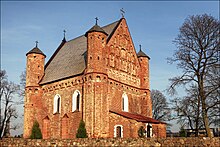

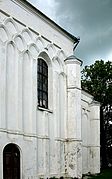



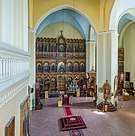
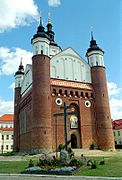
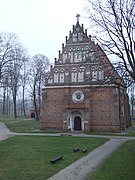
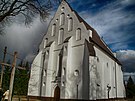
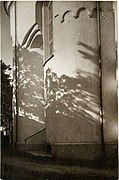
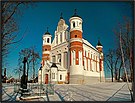
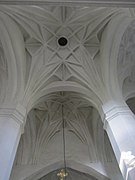
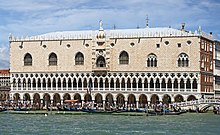










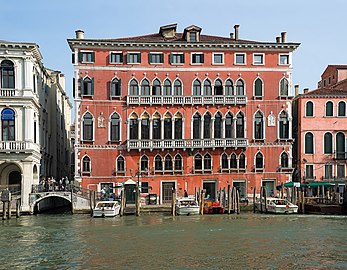


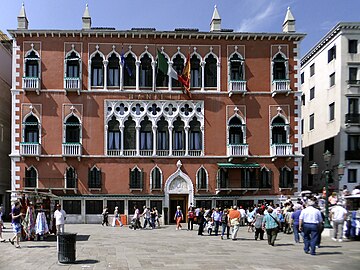
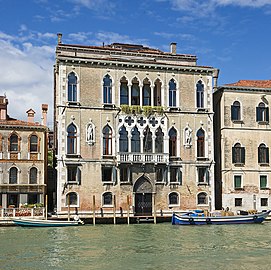
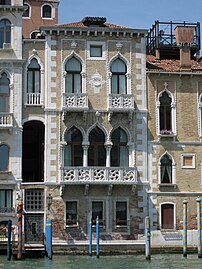



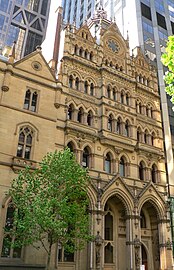
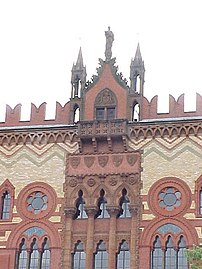
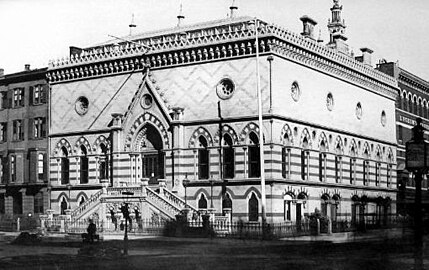



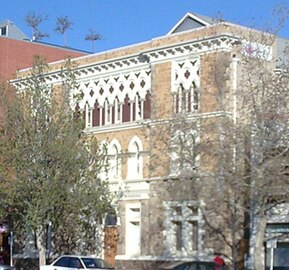





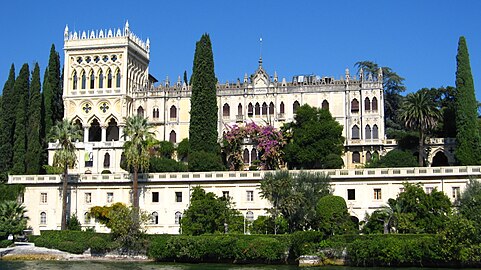

No comments:
Post a Comment